Infirmary (1859-1973)
Introduction
Text-to-speech Audio
Images
Infirmary Building

1930 photo of Infirmary building in the background behind trees.
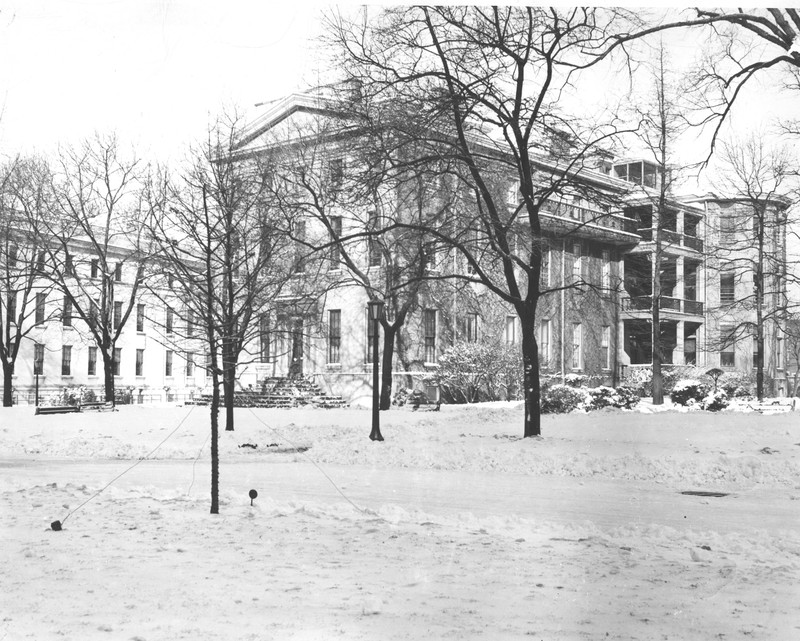
Students in beds inside Infirmary ward.
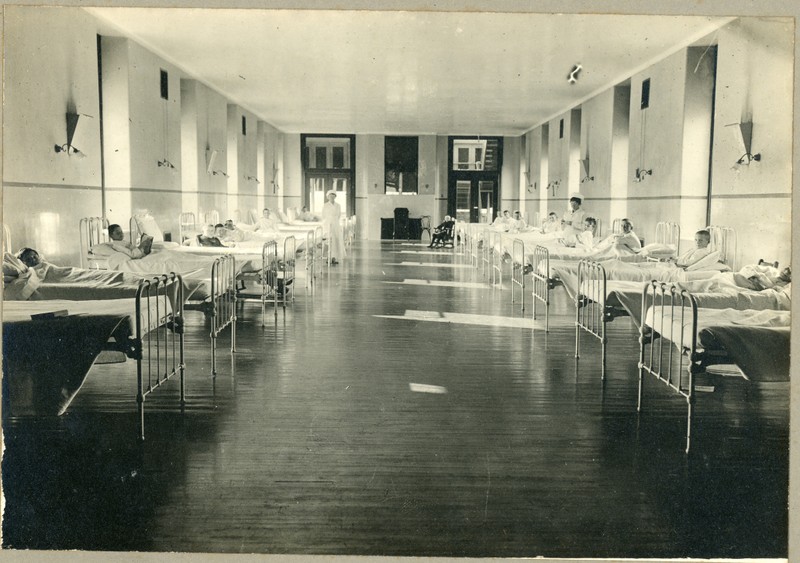
1960 photo of Infirmary doctor examining a student.
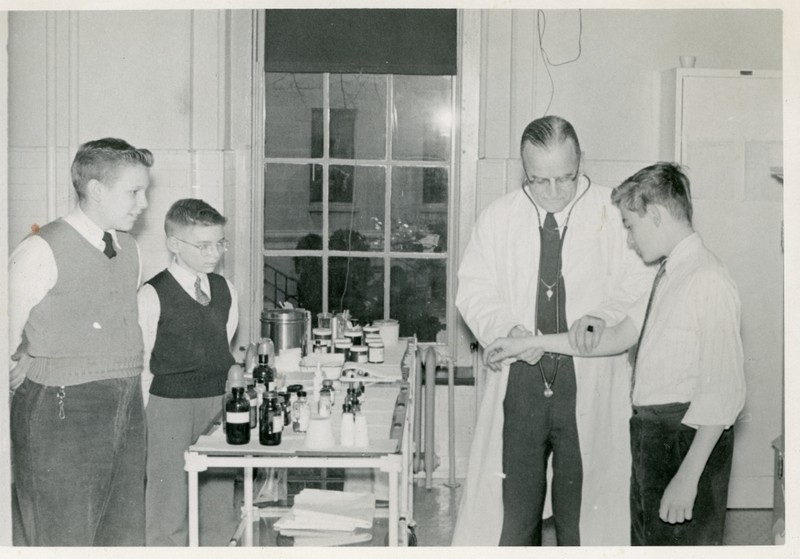
1950s photo of nurse examining a student’s teeth in dental clinic.

Photo of dentist standing in front of students seated in dental chairs of dental clinic's operating room.
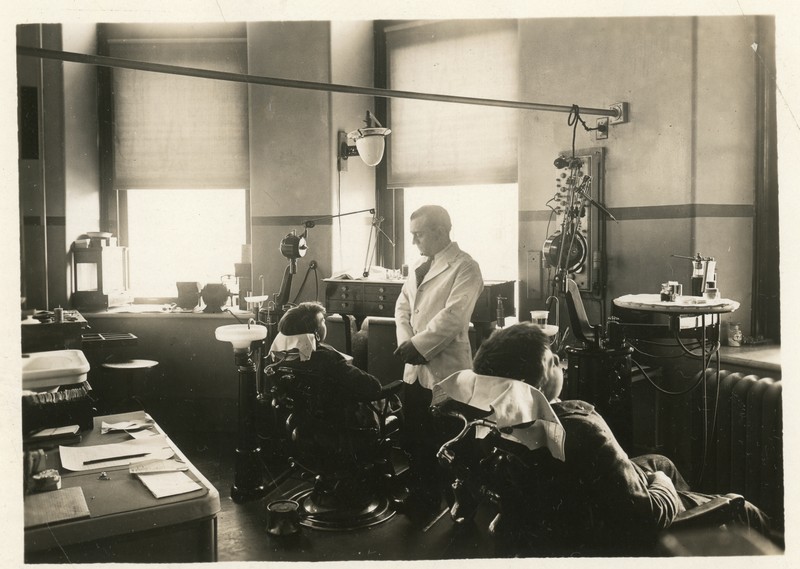
1939 photo of empty dining area and students in bed area while quarantining in Armory during scarlet fever epidemic.
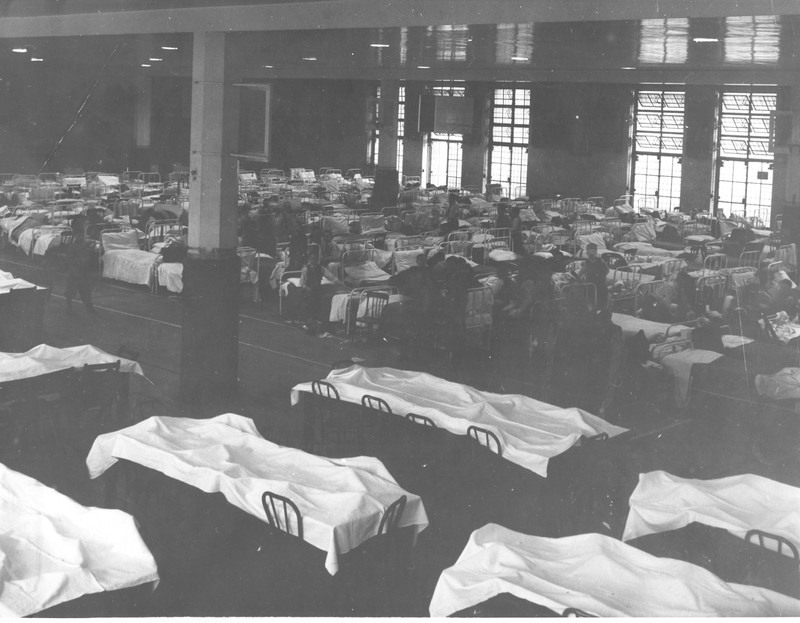
1939 photo of quarantined students playing ping-pong on roller skates in the Armory during scarlet fever epidemic.
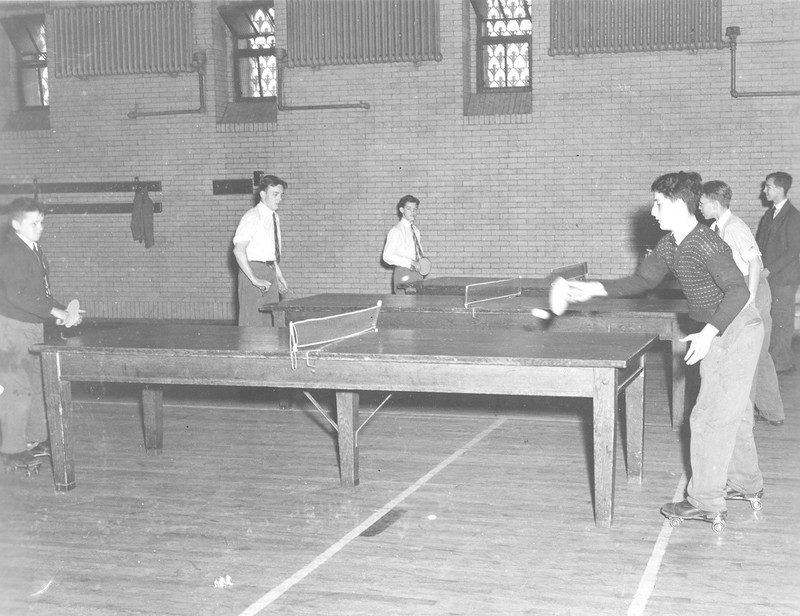
Backstory and Context
Text-to-speech Audio
Before the Infirmary was built, health services on Girard College’s campus were located in Building #4 (Merchant Hall). As the student population grew in the late 1850s, the boarding school decided to upgrade its medical facilities by erecting a building specifically for an infirmary, and Building #6 was opened in 1859. Due to its exterior appearance, the brick building was criticized by the Visiting Committee of the City Councils for being unsightly and out of place compared to the white marble buildings on campus. The first floor of the two-story Infirmary building was comprised of eight fireproofed patient wards, doctor’s offices, nurses’ rooms, a medicine room, and a parlor. The second floor consisted of an additional eight fireproofed wards, a treatment room, a sitting room, and linen rooms. Storage rooms were located in the basement. The building also had isolation rooms for patients with contagious illnesses, a diet kitchen, a pharmacy, baths, and toilets. The Infirmary possessed infrastructure for proper ventilation, double walls for insulation, air ducts for fresh air circulation, hot water apparatuses for heating located in a fireproof room, and iron fireproof stairways. A fenced-in playground exclusively for student patients was arranged on the grounds next to the building.
When the Infirmary was enlarged in 1880 to accommodate the rapidly growing student population, a third floor with additional wards and nurses rooms was added, along with a medical dispensary and dental room on the first floor. After a diphtheria epidemic afflicted more than 100 students in 1897, Girard College decided that it was necessary to enlarge the Infirmary again. The renovated, L-shaped building was completed in 1898, with an additional south wing and a marble exterior to match all other campus buildings. The new Infirmary held a total of 200 beds. Each of the three floors had a balcony to provide open fresh air spaces for sick patients, as well as indoor solariums. At the turn of the 20th century, the Infirmary had operating rooms set up for surgical services so that students would no longer need to be transferred to the neighboring hospital for surgery. The building was further enlarged in 1911, resulting in the transformation of a first floor ward into a dental clinic that included a dental operating room and a dental technical laboratory. Some nurses’ rooms on the third floor were remodelled into better-quality isolation wards in 1916, which became much more effective in inhibiting the spread of contagious disease as well as improving the general health of the student and staff body.
Throughout its history, the Infirmary had staff and specialists that provided services in general health, dentistry, and surgery. Between 1848-1884, Girard College had one physician assigned to conduct physical examinations for all admission applicants, and another physician to treat students and staff who were sick. In 1885, this arrangement was discontinued in favor of hiring a resident physician and appointing six on-call physicians for severe cases. These roles were again replaced with new positions for a college physician and visiting physician in 1923. Physicians continued to regularly conduct physical examinations for all students, and students who were identified to have physical deficiencies, such as poor posture, took “corrective gymnastics” exercises directed by the corrective gymnastics teacher. Instrumental in day-to-day health services were the nurses, who were supervised by a head nurse. Girard College was required to have at least one part-time dentist, a role which was eventually upgraded to the position of dentist-in-chief. The dental clinic was also staffed by assistant dentists, an exodontist (dentist that extracts teeth), orthodontist, oral hygienist, dental technician, and dental records clerk. Beginning in the 1880s, the Infirmary had access to the professional laboratory testing services and dispensary services of Lankenau Hospital, which was located directly across from the school’s main entrance until it moved in 1953. The Infirmary also referred students to Lankenau Hospital for surgery until the Infirmary instituted its own operating rooms and surgical services in 1902, staffed by on-call consulting surgeons and a nurse anesthetist. The Infirmary had an appointed ophthalmologist (physician that treats the eye) and otolaryngologist (physician that treats the nose, ears, and throat) as well. Both conducted physical examinations of each student upon his enrollment to the school. The eye department’s primary services were to prescribe eyeglasses for students and provide treatment for optical issues. The nose, ear, and throat department often performed surgical operations for newly admitted students, such as throat surgery to reduce tonsillitis and ear surgery to reduce ear diseases. Most of the Infirmary’s surgical services were discontinued in 1958.
Girard College’s health services progressed and expanded along with advances in medicine and treatment. In the 1860s and 70s, the popular remedy castor oil was commonly prescribed as a laxative, to the extent that the Infirmary was dubbed by students as the “castor oil house”. Calomel and salts, another popular Victorian cure-all, were often used towards the end of the 19th century. Students with moderate or serious health concerns may have been required to stay in an Infirmary ward for anywhere between one night to months at a time, under the supervision of nurses and staff. If a boy was severely ill or injured and had a mother or guardian living close to campus, the family member was contacted to come to campus to comfort their child and be informed of his health condition. Despite the Infirmary’s efforts, the limits of pre-modern medical care meant that a handful of students died each year, particularly during local outbreaks of contagious diseases. If a student died and his family could not arrange for burial, the deceased boy was interred in a cemetery on the west end of campus; in 1882 the school acquired a plot in Laurel Hill Cemetery for student burials.
The student and staff body were struck by an array of epidemics throughout the 19th century, including the 1851 dysentery epidemic, smallpox in 1863, an 1884 epidemic of meningitis, multiple typhoid fever outbreaks that occurred until a water filtration system was installed on campus in 1893, and an 1897 epidemic of diphtheria. By the turn of the 20th century, epidemics became less frequent at Girard College due to better campus sanitation and food safety procedures, improved practices of early diagnosis, and the prompt assignment of contagious students to isolation wards. Beginning in the 1910s, the Infirmary administered immunizations and vaccinations to all admitted students in order to prevent highly contagious diseases such as diphtheria and smallpox. Campus health services also favored corrective, remedial, and preventive treatments. Even so, these measures could not prevent the worldwide 1918 influenza pandemic from infecting students and staff on campus in September and October of 1918. In accordance with orders from health authorities and advice from its own medical staff, Girard College suspended classes for three weeks, imposed a roughly month-long quarantine that prohibited visitors from entering the school, and closed down all large indoor spaces except for the dining halls. Since students could not leave campus grounds, they were brought out onto the playgrounds as much as possible to get open fresh air. The flu epidemic resulted in about 1000 cases at Girard College and claimed the lives of 9 students. Twenty years later, a major epidemic of scarlet fever broke out in 1939. The school once again implemented a 3-month quarantine confining students to campus, halted all classes and group assemblies for two weeks, limited student activity, and had all students and staff tested. The Infirmary soon became fully occupied, necessitating a makeshift infirmary in the Junior School Building. The 400 boys (¼ of the student body) who tested as being susceptible to scarlet fever were quarantined together for four weeks in the campus Armory to prevent them from becoming infected. In the end, there were 93 reported cases of scarlet fever. The last notable epidemic to occur before the Infirmary closed was the 1957 flu pandemic, which resulted in approximately 145 student cases.
The Infirmary building was demolished in 1973, since a smaller student population and advances in modern medicine meant that such a large building was no longer needed. The grounds were transformed into a campus green space in 1977, and the Tuttle pavilion now sits where the former Infirmary once stood. Today, on-campus student health services are located in the Junior School Building.
Cite This Entry
Karen Li on behalf of Girard College and Katherine Haas. "Infirmary (1859-1973)." Clio: Your Guide to History. December 17, 2020. Accessed August 14, 2025. https://theclio.com/entry/105000/tour/11
Sources
DiFilippo, Thomas J. Stephen Girard, The Man, His College and Estate. Edition 2nd. 1999. Accessed August 24 2020. http://www.girardweb.com/girard/contents.htm.
Girard College, Annual Reports of the Board of Directors of the Girard College of Orphans. Philadelphia, PA.
Girard College. President's Reports and Catalogue of Pupils - Girard College, The City of Philadelphia, Trustee. Philadelphia, PA.
Herrick, Cheesman A. History of Girard College. Philadelphia, PA. Girard College, 1927.
Scattergood, David. Hand Book of Girard College. Illustrated. Philadelphia, PA. D. Scattergood, 1888.
Zesinger, Frank O. "Care of the Health of Boys in Girard College, Philadelphia, PA." United States Bureau of Education Bulletin, vol. 614, no. 40. Published 1914. Accessed September 1 2020. https://archive.org/details/ERIC_ED541722/mode/1up.
Girard College Historical Collections.
Girard College Historical Collections.
Girard College Historical Collections.
Girard College Historical Collections.
Girard College Historical Collections.
Girard College Historical Collections.
Girard College Historical Collections.
Girard College Historical Collections.

